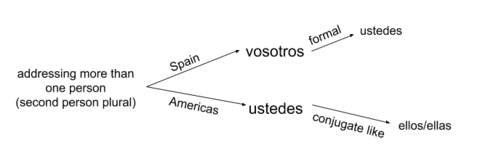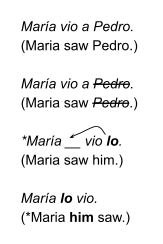Types of Pronouns in Spanish
A pronoun stands in for a noun and allows speakers to avoid repeating full nouns or names over and over again once the topic has been established. In this guide, we cover nine types of pronouns in Spanish which help distinguish how the original person, place, or thing is involved with the event described in the sentence.
Spanish pronouns:
- can stand in for subjects, objects, and indirect objects
- need to be changed according to the gender and plurality of the noun (most of the time)
- can express formality/demonstrate respect
- are usually left out when in subject position
- can express who something belongs to (possessive)
- are placed before the verb when referring to a direct or indirect object
- can express an unspecified person or entity (indefinite)
- can be used to point something out (demonstrative)
Spanish pronouns include:
- subject pronouns (replace the subject of the sentence i.e. “[subject] smiles”)
- possessive pronouns (replace an item that’s owned by someone, i.e., “This is mine”)
- direct object pronouns (replace the direct object of the sentence, i.e., “[subject] throws [direct object]”)
- indirect object pronouns (replace the indirect object of the sentence, i.e., “[subject] gives [direct object] to [indirect object]”)
- prepositional object pronouns (used after a preposition, i.e., “Dance with me!”)
- reflexive pronouns (used when an action is being done to oneself, i.e., “She loves herself”)
- relative pronouns (used to relate a noun to another, i.e., “…the people who I met”)
- indefinite pronouns (replace a non-specific entity, i.e., “…anything that you want”)
- demonstrative pronouns (make reference to something, i.e., “this and that”)
Luckily, pronoun forms are very closely related, so it’s usually easy to figure out what they mean when reading or listening to Spanish. On the flip side, one letter or accent mark can completely change the meaning, meaning their relatedness can lead to some difficulty when speaking or writing Spanish.
Some Spanish pronouns are used differently than English ones, so reading and listening to Spanish is crucial to noticing how they are used by native speakers. Exposing yourself to as much Spanish as possible is the best way to get the hang of pronouns (especially indirect pronouns which get moved before the verb!).
Try going on a pronoun scavenger hunt by listening to podcasts or watching Spanish films and identifying the different types. The best way to learn Spanish online is with Lingvist, which offers grammar hints on pronouns, and much more!

Science says there’s a faster way to learn Spanish
Subject Pronouns
The subject of the sentence is the main noun that is doing or being something. It is the person, place, or thing that you must conjugate your main verb to match. The subject pronoun distinctions in Spanish correspond closely to categories in English, with the exception of vosotros, for which the English counterpart would be “you all” or “you guys.”
| Person | English | Spanish |
|---|---|---|
| first person singular | I | yo |
| second person singular | you/you (formal) | tú/usted |
| third person singular | he/she/it | él/ella |
| first person plural | we | nosotros |
| second person plural | you (plural) / you (plural + formal) | vosotros/ustedes |
| third person plural | they (masc./fem.) | ellos/ellas |
Note that the accents on tú and él are crucial, as they distinguish them from the possessive adjective tu (“your”) and the determiner el (“the”).
Gender
Just as the English pronouns he/she denote gender, Spanish pronouns also need to be changed depending on who you are speaking about. Unlike English, the plural pronouns “we” (nosotros/nosotras), “you all” (vosotros/vosotras), and “they” (ellos/ellas) need to be changed to match the gender of the group.
The letter “a” is related to feminine words, while “o” is masculine. If the group is mixed, use the masculine form, just like “you guys” is used for a mixed group in English (as opposed to “you girls”).
English uses “it” to refer to a non-human or an animal (that isn’t a pet) when the gender is unknown. In Spanish, every noun has an arbitrary gender, even if it’s inanimate. For example, the noun “chair” (la silla) is feminine, so the associated pronoun is ella.
For simplicity’s sake, most Spanish guides will only list the distinction between él/ella and ellos/ellas in conjugation charts, but remember that the other plural forms also need to be changed to match an all-feminine group (vosotras and nosotras).
Formality: Usted/Ustedes
Spanish allows you to express respect or formality by using usted/ustedes instead of tú when speaking to someone older than you or in a higher social position (the CEO of the company, the president, your professor). Note that the same conjugation is used for usted or ustedes as you would for él/ella or ellos/ellas respectively, so it often appears grouped together in conjugation charts. When abbreviated, Ud./Uds. needs to be capitalized at all times; if written out (usted/ustedes) they follow the usual capitalization rules.

The vosotros form of the verb is used mainly in Spain. It is not as common in Latin America, where they simply use the formal (which has lost its formality in this context) ustedes conjugation (same as ellos/ellas). Depending on where you plan to use your Spanish the most, Lingvist’s online Spanish course allows you to select either Neutral or American Spanish.

Subject Pronouns for Emphasis
Now that you’ve learned all of the subject pronouns, you can essentially forget about them!
Well, not entirely, but Spanish is a null-subject language. This means that as long as it’s clear from the context, you can leave out the subject and simply use the conjugated verb to denote who you’re referring to.
In most cases, conjugations in Spanish communicate very clearly who the verb is referring to. Spanish has a very rich inflectional morphology, which means that there are many verb endings that encode this information directly into the verb. Compare this with English, in which verbs generally only change in the third person singular (I walk / You walk / He/She/It walks). Without a subject pronoun in English, it would be extremely confusing to figure out who walked.
In the first person and second person forms, it’s generally quite clear who the speaker is and who the direct addressee is, so usually Spanish speakers leave out yo and tú right off the bat. However, when first introducing a third person entity into a conversation, you’ll of course need to use a subject. Afterwards, when a subject pronoun would usually be necessary in English, you can simply skip it and go straight to the verb.
El gato saltó dentro de la caja. Entonces __ maulló._ (The cat jumped into the box. Then it meowed.)
If it’s clear who/what is being discussed, you’ll hear subject pronouns being used for emphasis. Often these are introduced in a corrective or contrastive situation, where the speaker wants to draw attention to the fact that it was that person that is associated with the event/action. In English, the same effect is sometimes achieved using a special “prosody,” or vocal inflection, or with other words/phrases, such as “as for me” or “actually.”
__ No está allí.. (He isn’t there.)
vs.
En realidad, él está allí. (Actually, he is there.)
__ Puede pensar que eso es normal, pero yo nunca haría algo así. (He may think that’s normal, but I would never do something like that.)
__ Le gusta la vainilla. Yo prefiero el sabor a chocolate. (She likes vanilla. As for me, I prefer the chocolate flavor.)
Possessive Pronouns

Just like English, Spanish uses possessive pronouns as shorthand to stand in for a noun which belongs to someone/something. Most commonly, these are used when it’s already clear from the discourse context which item is being discussed or when a speaker is indicating or pointing at an item.
However, in Spanish the possessive pronoun requires a definite article (“the”), which also needs to be changed to match the gender of the replaced noun.
Tu piso está en la segunda planta; el mío en la tercera. (Your apartment is on the second floor; mine on the third.)
The exception to this rule is after the verb ser (“to be”):
Esto es mío. (This is mine.)
Ese coche es tuyo? (Is that your car?)
| Masculine | Feminine | English |
|---|---|---|
| el mío/los míos | la mía/las mías | mine |
| el tuyo/los tuyos | la tuya/las tuyas | yours |
| el suyo/los suyos | la suya/las suyas | his/hers/its |
| el nuestro/los nuestros | la nuestra/las nuestras | ours |
| el vuestro/los vuestros | la vuestra/las vuestras | yours (plural) |
| el suyo/los suyos | la suyo/las suyos | theirs |
Remember that the appropriate pronoun will need to match both the gender and number of the noun being replaced (-a or -o, -os or -as), as well as the person being discussed, which in the case of “you,” includes plurality as well (whether you’re addressing one person or multiple).
Luckily, the possessive pronouns for “his/hers/its” and “theirs” are the same, which saves you some mental gymnastics in those cases!
Watch Out for Possessive Adjectives
Possessive pronouns are very similar to possessive adjectives but are always the longer version of the two. The appropriate use of possessive pronouns versus possessive adjectives also mirrors the familiar English usage. While a pronoun stands in for a noun, an adjective “modifies,” or describes, a noun. Simply put: if there’s no noun present, it’s a possessive pronoun.
Esto es tuyo. (This is yours.)
If there’s something that looks similar to a subject pronoun + a noun, it’s a possessive adjective. See our guide to Spanish adjectives for more on how to use these.
Este es tu lápiz. (This is your pencil.)
Direct Object Pronouns
The direct object is the object that directly receives the action of the main verb or is the thing/event caused by the main verb. For example, “book” is the direct object in “She bought a book,” while “She” is the subject who performed the action. To see the direct object more clearly, change a sentence into a question about what the subject did:
What did she buy? She bought a book.
Where did she go? She went to Colombia.
What did the doctor perform? He performed heart surgery.
Just like English, you can replace the direct object with a pronoun once you’ve already established what noun you’re referring to. So, if you’re already discussing a certain book in a conversation, you could save time and simply say “She bought it.”
| Spanish Direct Object Pronoun | English Direct Object Pronoun |
|---|---|
| me (pronounced “meh,” not “me”) | me |
| te | you |
| lo/la | him/her/it |
| nos | us |
| os | you (plural) |
| los/las | them |
As we mentioned above, Spanish nouns all have a gender (which is why Spanish doesn’t have a gender neutral translation of “it”). So, whether it is a person, place, or thing, you’ll need to choose the matching direct object pronoun so that it’s clear what you’re referring to. For example, if you’re talking about Maria seeing multiple of the masculine verb for “bird” (pájaro), you would say:
María los vio. (Maria saw them.)
Did you notice that the pronoun occurs before the verb? That brings us to our next very important point.
Direct Object Pronoun Placement
When the direct object has been replaced by a pronoun, it gets moved up in Spanish.

*The asterisk here denotes an ungrammatical sentence in that language, simply used to illustrate the movement and to provide a direct word-for-word translation.
If the verb requires a preposition (like “talked with” or “jumped on”), the direct object pronoun stays in place; however, it requires a different pronoun in this case. See the section below on prepositional object pronouns for more.
Exceptions to Direct Object Movement
As we mentioned above, in most cases the direct object pronoun gets moved up before the verb.
Juan le dio el regalo. (*Juan her gave the gift.) (Juan gave her the gift.)
However, there are a few exceptions to this rule in which you instead attach the direct object directly to the end of the verb.
Exception 1: When using a command (imperativo/imperative)
When telling someone to do something, add the indirect object pronoun directly to the end of the conjugated verb.
Decir (“to say” infinitive) Di (conjugated tú form of imperativo) Di + lo (add direct object pronoun for “it”)
¡Dilo! (Say it!)
Exception 2: When using an infinitive
When you’ve already conjugated one verb in a sentence, you don’t need to conjugate the following verbs that you’re stacking up. If the direct object refers to an infinitive verb, you have the option to attach it directly to the end or move it up in front of the conjugated verb. These infinitives can be directly after the conjugated verb or occur later, after a word like para or por (“for/in order to”).
Debes tomar lo. Lo debes tomar. (You have to take it.)
Debes pagarlo para tomar lo. Debes pagar para tomarlo. Lo debes pagar para tomarlo. (You have to pay to take it.)
Exception 3: When using a conjugated verb + -iendo/-ando verb form
The -iendo/-ando form of the verb is called the present participle or gerund, and denotes that an action is currently occurring. It correlates to the “-ing” ending in English. In this case, you have the option to move the direct object pronoun up in front of the conjugated verb, or attach it directly to the present participle.
Estoy comiéndo lo. Lo estoy comiendo. (I am eating it.)
Note the change of “e” to “é” in comiendo. The addition of the lo at the end means that that syllable becomes stressed, which is marked with this written accent.
Indirect Object Pronouns
The indirect object is not the primary recipient of the action of the verb, but it tells us what/who is affected by the verb. In many cases, this describes “to whom” the direct object is “given to” or “performed on.”

Indirect objects are associated with a transitive verb (like “give”), which requires at least two nouns. A verb like “give” requires someone/something to perform the action (subject), someone/something to receive the action (direct object), and someone/something to be involved with the action or event (indirect object).
John le dio el libro. (*John to her gave the book.) <– direct translation (John gave the book to her.) <– English translation
You may also see a double dative used to add extra emphasis (perhaps when information needs to be corrected in the conversation). In these cases, we add the indirect object twice:
John le dio el libro a ella. (*John to her gave the book to her.) (John gave the book to her.) <– English translation
| Spanish Indirect Object Pronoun | English Indirect Object Pronoun |
|---|---|
| me (pronounced “meh,” not “me”) | to me |
| te | to you |
| le/se* | to him/her/it |
| nos | to us |
| os | to you (plural) |
| les/se* | to them |
This can be tricky, and the double dative can make the logic seem obtuse to English speakers at first. Here’s a demonstration of when to use direct object or indirect object pronouns in Spanish.
With some transitive verbs, the indirect object or the direct object can be left out. But if you think about it, it’s usually still implied that it exists. For example, “The doctor performed heart surgery” is a complete sentence, but it’s still understood that an indirect object, namely a living being with a heart, was affected by the action.
In both English and Spanish, there are instances where you may notice that either the indirect object or the direct object is left out. This is only in cases where the meaning is clear from earlier information in the conversation.
See if you notice the “missing” direct object in the following dialogue:
– “María ya sabe qué sucedió.” – “¿Cómo lo sabe?” – “Guadalupe le contó” OR “Guadalupe se lo contó.”
Guadalupe le contó. (*Guadalupe him/her told) <– direct translation (Guadalupe told him/her <something(direct object)>) <– English translation
Alternatively, the example below has all of its objects:
Guadalupe se lo contó. (*Guadalupe to him/her it told) (Guadalupe told it to him/her.)
Using Direct Object and Indirect Object Pronouns Together
When replacing both the direct object and the indirect object with a pronoun, the indirect object always comes first. In the following example, te (“to you”) is the indirect object and lo (“it”) is the direct object, while él is our subject pronoun.
Él te lo dijo. (*He (to) you it told.) <– direct translation (He told you it.)
When to use se
If two pronouns that both begin with the letter “L” occur next to each other, the pronunciation of the sentence would be too difficult. In this case, replace the first pronoun (indirect pronoun) with se, in both the singular and plural, so that the sentence flows more easily!
*Él le lo dijo. Él se lo dijo. (*He (to) him it told.) <– direct translation
(He told him it.) <– English translation
Prepositional Object Pronouns
A preposition describes where an object is or how it relates to someone/something. In English these are words like “in,” “on,” “after,” and “for.” Use prepositional object pronouns when replacing a noun after a preposition:
Ese regalo es para ti. (This gift is for you.)
¡No puedes ir a España sin mí! (You can’t go to Spain without me!)
| Spanish Prepositional Object Pronoun | English Prepositional Object Pronoun |
|---|---|
| mí/ conmigo* | me |
| ti/usted/ contigo* | you |
| él/ella | him/her |
| nosotros/nosotras | us |
| vosotros/vosotras/ustedes | you |
| ellos/ellas | them |
Note that the English translations of these pronouns are the same as direct object pronouns, and they also sometimes refer to direct objects, which is why English speakers need to pause and think about which to use. Don’t worry – with practice these will start to come naturally.
The accent mark in mí differentiates it from the possessive pronoun mi (“my”). Apart from mí and ti, these are the same as the subject pronouns.
*When using mí and ti after the word con (“and”), you’ll need to use conmigo or contigo.
¡Baila conmigo! (Dance with me!)
Note: If someone asks a question starting with “who,” such as “who wants to go?”, in English you would reply either “me” or “I do.” In Spanish, you should simply say yo (“I”), not mí (“me”).
Reflexive Pronouns
Reflexive verbs are used to talk about actions that one does to oneself, such as washing oneself (lavarse), dressing oneself (vestirse), or calling oneself, i.e., “to be named” (llamarse). Reflexive verbs are not found in English, so they can be difficult to remember in Spanish.
Some verbs are inherently reflexive in Spanish, but you can also make a verb reflexive by adding a -se at the end of its infinitive form, almost like a built-in pronoun. When conjugating, think of removing the -se, moving this pronoun in front of the verb, and then changing it to reflect the correct gender and number.
| Spanish Reflexive Pronoun | English Reflexive Pronoun |
|---|---|
| me (pronounced “meh,” not “me”) | myself |
| te | yourself |
| se | himself/herself/itself/yourself (formal) |
| nos | ourselves |
| os | yourselves |
| se | themselves/yourselves (formal) |
These pronouns look similar to direct object and indirect object pronouns, with the exception of se. Note that se is also used for the formal “you” (usted/ustedes).
Me ducho. (I shower <myself>.)
¿Como se llama? (What does he call himself?) <– literal translation (What is his name?) <– English translation
Relative Pronouns
Relative pronouns allow you to relate a noun to something else or express a specific relation between a noun and its description.
La flor que compré es hermosa. (The flower that I bought is beautiful.)
These aren’t exactly traditional pronouns, as they aren’t used to replace a noun but to connect it with its modifying phrase instead. Luckily, they are used in a very similar way to English relative pronouns, with the exception that it is common to omit them in English (“The one (that) I bought.”) In Spanish, you can’t skip the relative pronouns.
| Spanish Relative Pronoun | English Relative Pronoun |
|---|---|
| que | that/which/who/whom |
| quien/quienes | who/who (plural) |
| la que/el que/las que/los que | the one(s) who/that which |
| cuyo/cuya/cuyos/cuyas | whose |
In Spanish, you can use que (“that”) or quien(/es) (“who”) to refer to a person.
Esa es la persona que amo. Esa es la persona a quien amo. (That is the person who I love.)
Don’t forget that you need to make quien plural if referring to multiple people.
Esas son las personas a quienes amo. (Those are the people who I love.)
Use la que, el que, las que, or los que to describe a certain person/people (make sure to match the gender and number):
Hablé con María, la que está en mi clase. (I talked with Maria, the one who is in my class.)
Cuyo/cuya needs to match the gender of the noun which is “owned” by the main noun, not the gender of the person that you’re describing.
María, cuyo padre trabaja con mi padre, está en mi clase. (Maria, whose father works with my father, is in my class.)
María, cuya madre trabaja con mi padre, está en mi clase. (Maria, whose mother works with my father, is in my class.)
María, cuyos padres trabajan con mi padre, está en mi clase. (Maria, whose parents work with my father, is in my class.)
Indefinite Pronouns
Indefinite pronouns refer to an entity that is not defined (hence the word “indefinite”). These are used to talk about someone/something that is unknown (“someone”) or non-specific/irrelevant (“anyone”). Notice that some change to show gender/number, while others don’t.
| Spanish Indefinite Pronoun | English Indefinite Pronoun |
|---|---|
| alguien | someone/somebody, anybody/anyone |
| alguno/alguna, algunos/algunas | one/some/some people |
| algo | something |
| nada | nothing |
| nadie | nobody/no one |
| ninguno/ninguna | nobody/no one/none |
| cualquiera | anybody/anyone |
| todo/toda, todos/todas | everyone/everybody, all |
| uno/una, unos/unas | one, some |
| poco/poca, pocos/pocas | little, little bit, few, a few |
| mucho/mucha, muchos/muchas | many, much, a lot |
| otro/otras, otros/otras | others, another one, other one |
You can use mucho(/-a/-os/-as) and poco(/-a/-os/-as) with a relative pronoun, just as you use “much,” “many,” or “few” in English:
Hay mucho que hacer. There is much
Hay muchos que piensan así. There are many who think like that.
Hay pocos que irían allí. There are few who would go there.
Demonstrative Pronouns

Demonstrative pronouns are used to point something out in your current visual context or “demonstrate” which person/thing you mean to refer to.
| Spanish Demonstrative Pronoun | English Demonstrative Pronoun |
|---|---|
| este/esta, estos/estas | this, these ones |
| esto | this thing / this matter / this topic |
| ese/esa, esos/esas | that / that one, those ones |
| eso | that thing / that matter / that topic |
| aquel/aquella, aquellos/aquellas | that one over there, those ones over there (for something further away) |
| aquello | that thing / that matter / that topic |
Be careful not to confuse the two very similar meanings of esta (“this”) and the third person singular conjugation of the verb estar (“to be”): está.
Imagine in this example the speaker is in a bookshop, pointing to a particular book:
Ya he leído eso. Es bueno. I’ve read that one. It’s good.
While demonstrative pronouns that replace another noun need to be changed to match the gender and number, esto, eso, and aquello only stand in for a specific noun: “thing/matter/topic.”
In this example, the noun being replaced is a yet-unspecified “thing,” not a known noun like the example with “book” above. In this second sentence the speaker is referring to a “thing” or topic, perhaps the topic of the book:
Sé de eso. Es un tema común. I know about that / that thing / that matter / that topic. It’s a common topic.
Watch Out for Demonstrative Adjectives
Demonstrative adjectives look just like demonstrative pronouns, except that as they are adjectives, they need to occur with the noun that they describe. Demonstrative pronouns replace a noun rather than modify it.
Esta bebida es deliciosa. (This drink is delicious.)
Esto es delicioso. (This is delicious.)
Pronouns are worth it – we promise!
If you made it to the end of this lengthy description of pronouns, you’re probably thinking you’d rather just stick to nouns from now on. Although this choice is technically up to you, pronouns are very powerful tools for making conversation more efficient.
Juan dijo que dio el regalo a María. (Juan said that he gave the gift to Maria.)
vs.
Dijo que se la dio. (He said that he gave it to her.)
All those milliseconds you save add up over time! Comparing the sentences above should leave you feeling empowered to start using all of the pronouns and save yourself lots of time and effort.
Sign up on Lingvist today to start practicing all nine of these forms of pronouns.

